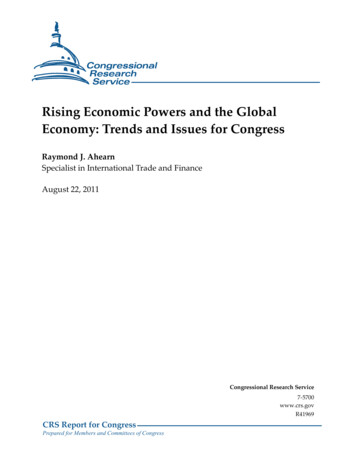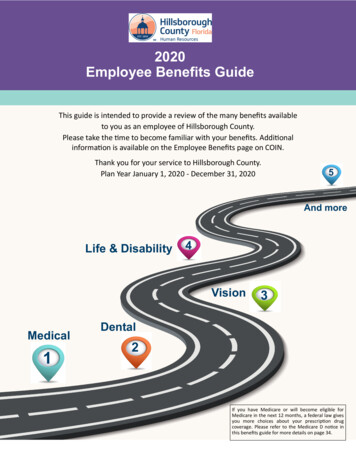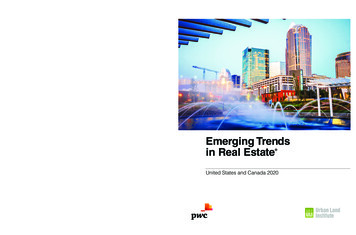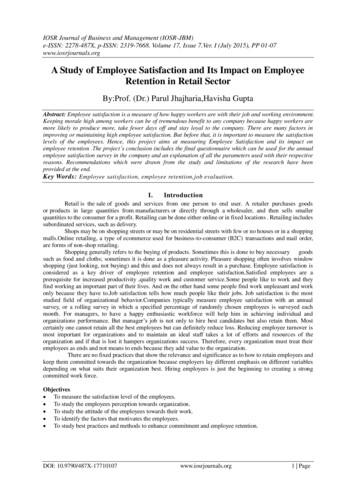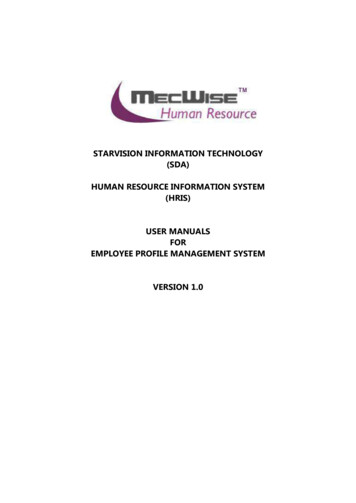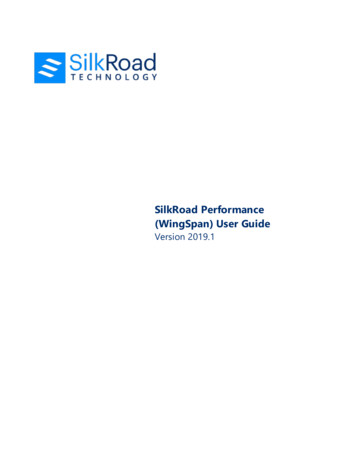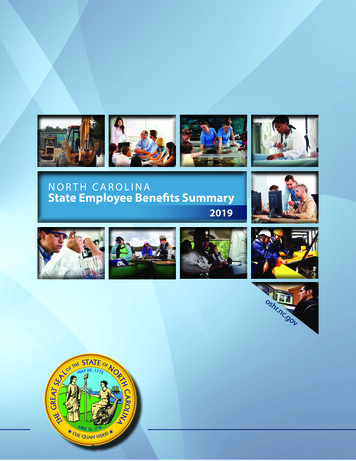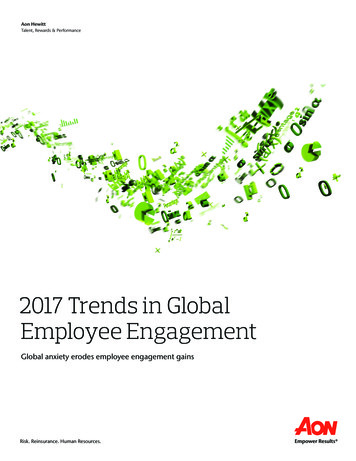
Transcription
Aon HewittTalent, Rewards & Performance2017 Trends in GlobalEmployee EngagementGlobal anxiety erodes employee engagement gainsRisk. Reinsurance. Human Resources.
Table of ContentsExecutive Summary. . . . . . . . . . . . . . . . . . . . . . . . . . . . . . . . . . . . . 1Employee Engagement Defined. . . . . . . . . . . . . . . . . . . . . . . . . . . 2About the Study. . . . . . . . . . . . . . . . . . . . . . . . . . . . . . . . . . . . . . . 3Key Findings . . . . . . . . . . . . . . . . . . . . . . . . . . . . . . . . . . . . . . . . . . 4Engagement by Country . . . . . . . . . . . . . . . . . . . . . . . . . . . . . . . . 6Global Employee Engagement. . . . . . . . . . . . . . . . . . . . . . . . . . . . 7A Slowing in Asia Pacific . . . . . . . . . . . . . . . . . . . . . . . . . . . . . . . . . . . . . . . . 8Different Directions in Latin America . . . . . . . . . . . . . . . . . . . . . . . . . . . . . . 9Stability in North America?. . . . . . . . . . . . . . . . . . . . . . . . . . . . . . . . . . . . . 10A Rocky Road in Europe . . . . . . . . . . . . . . . . . . . . . . . . . . . . . . . . . . . . . . . 11Rebound in Africa. . . . . . . . . . . . . . . . . . . . . . . . . . . . . . . . . . . . . . . . . . . . 12Conventional Wisdom Upended . . . . . . . . . . . . . . . . . . . . . . . . . 13Final Thoughts . . . . . . . . . . . . . . . . . . . . . . . . . . . . . . . . . . . . . . . 15Contacts . . . . . . . . . . . . . . . . . . . . . . . . . . . . . . . . . . . . . . . . . . . . 1622017 Trends in Global Employee Engagement
Executive SummaryThe significant increases of employee engagement in 2016 have been partiallyerased. Populist movements like those seen in the United Kingdom, theUnited States, and those taking hold in parts of Continental Europe havemade discussions about erecting borders and walls more common. If realized,these moves will restrict the flow of labor between countries and change theeconomic rules of the game. Thus, anxiety is permeating the workplace.If that wasn’t enough, rapid technology advances that could make many jobsobsolete are no longer the subject of science fiction, and are here to stay.Driverless cars, drones, virtual reality, artificial intelligence, machine learning,and other technologies are competing for jobs like never before.These changes present new challenges for CEOs, Human Resources leaders,and leaders of all levels. Left unaddressed, populism and more sophisticatedtechnology advances will create further angst in organizations and, thus, willcause the work experience and employee engagement to decline even more.Global Trends in Employee EngagementEmployee engagement peaked in 2015, but its gains were wiped away with a two-point drop in 2016.Global Engagement75%Engagement 201420152016YearAon Hewitt1
Employee Engagement DefinedThe concept of employee engagement is often confused with satisfaction or happiness.However, the true definition is deeper in meaning. Employee engagement is definedas “the level of an employee’s psychological investment in their organization.”The Trends in Global Employee Engagement Study measures employeeengagement with a Say, Stay, Strive model. Employees are asked: If they Say positive things about their organization and act as advocates If they intend to Stay at their organization for a long time If they are motivated to Strive to give their bestefforts to help the organization succeedThe Aon Hewitt Engagement ModelThe Aon Hewitt Employee Engagement model provides a complete pictureof the business impact of engagement, employee engagement itself, andthe factors of the work experience that lead to higher engagement.The Aon Hewitt Engagement ModelFoundation and/EVPCorporate ormanceCompanyPracticesThe WorkThe BasicsTalentSayLeadershipSenior leadershipBU leadershipPerformanceCareer opportunitiesLearning and developmentPerformance managementPeople managementRewards and sfactionNPSRetentionStriveCompany PracticesCommunicationCustomer focusDiversity and inclusionEnabling infrastructureTalent andng2The BasicsBenefitsJob securitySafetyWork environmentWork/life balance2017 Trends in Global Employee EngagementThe WorkCollaborationEmpowerment/autonomyWork tasksFinancialRevenue/sales growthOp. income/marginTotal shareholder return
About the StudyEvery year, Aon Hewitt measures employee engagement for more than1,000 organizations around the globe. This study has been conducted usingdata from more than five million employee responses in 2015 and 2016.The responses come from organizations with as few as 100 employees tothe most complex organizations with hundreds of thousands of employees.More than 60 industries are represented in the study.In addition to measuring employee engagement, this study also measures15 work experience dimensions: Employee Value Proposition (EVP), Reputation,Career Opportunities, Collaboration, Diversity and Inclusion, Empowerment/Autonomy, Enabling Infrastructure, Learning and Development, Manager,Performance Management, Rewards and Recognition, Senior Leadership,Talent and Staffing, Work Fulfillment, and Work/Life Balance.Aon Hewitt3
Key Findings2017 Global Engagement TrendsGlobal63%-2ptsLatin America64%75%-1ptTop EngagementOpportunitiesTop EngagementOpportunitiesRewards & Recognition-1Enabling InfrastructureEVP 1EVPSenior Leadership-1Career OpportunitiesEnabling InfrastructureEVP 3ptsTop EngagementOpportunities0Rewards & Recognition 2-2Senior Leadership 1Rewards & Recognition-1Enabling Infrastructure 1-5Senior -7Career Opportunities-2Largest PositiveDimension IncreasesLargest PositiveDimension Increases4North America 12017 Trends in Global Employee EngagementNoneLargest PositiveDimension IncreasesN/ATalent Staffing 4Rewards & Recognition 2EVP 1Enabling Infrastructure 1Senior Leadership 1
Africa61%Europe 2ptsCareer Opportunities-2ptsTop EngagementOpportunitiesTop EngagementOpportunitiesTalent & Staffing58%Asia Pacific 17062%-3ptsTop EngagementOpportunitiesRewards & Recognition 1Rewards & Recognition-2EVP 2EVP 1Rewards & Recognition-1Enabling Infrastructure-3Career Opportunities-4EVP 3Career Opportunities-5Work Fulfillment-3Senior Leadership 1Senior Leadership-1Work/Life Balance0Largest PositiveDimension IncreasesLargest PositiveDimension IncreasesTalent & Staffing 17Largest PositiveDimension IncreasesEVP 2Enabling Infrastructure 8Rewards & Recognition 1Collaboration 6Senior Leadership 1EVP 3PerformanceManagement 1EVP 1Aon Hewitt5
Engagement by CountryAs this report shows, global employee engagement has fallen. To better understandwhat is behind the global trend we need to examine engagement levels andyear-over-year changes by region and market. As we see in the graph below, there is agreat deal of variability in both engagement level and engagement trend across theglobe. Some of the engagement level variability is due to cultural differences where itmay be frowned upon to be overly enthusiastic or negative. Other factors like political oreconomic stability can influence engagement. The graph illustrates with the clustering ofthe largest bubbles (indicating relative market GDP and labor pool size) to the left of thevertical line, that the decrease in global engagement is a function of the engagementdecrease in engagement in the United States and many of the world’s other largestmarkets in Asia and Europe.Markets by Engagement Levels and Engagement TrendsEach circle represents a different country. The size of the circle represents the country’s percent of the global workforce plus the percent of thecountry’s global GDP. The color of the circle represent the country’s GDP growth. Dark red means a large GDP drop for the country, whereasdark green means a large GDP improvement.85%Colombia80%Mexico75%BrazilSaudi Arabia70%2016 Engagement65%IndiaChinaThe Philippines2016 Global Avg: (63%)CanadaVietnamUnited StatesThailandSouth KoreaIndonesia60%South ntina% of Global GDP &Labor 0%PolandThe P Growth 2015Japan-4%-8%-6%-4%-2%No Change 22015 to 2016 Engagement Change62017 Trends in Global Employee Engagement 4% 6% 8% 10% 12% 12% 14%
Global Employee Engagement“The uncertainty andcomplexity we saw last yearseems to have continued.Populist sentiment, politicallydivided nations, surprisingelection results, continuedtechnological disruptionacross industries make foreconomic and business jitters.As leaders have tried to adjustto a rapidly evolving globalreality, the average employeeacross the globe is left with agreat deal of fear and anxietythat threatens their fullengagement at work.”– Ken Oehler, Aon Hewitt’s GlobalCulture & EngagementPractice LeaderAround the world, employee engagement has retracted in the last year. The two-pointdrop of engaged employees nearly offset the three-point rise seen in the 2016 Trendsin Global Employee Engagement Report. Just 24 percent of all employees fall into theHighly Engaged category and another 39 percent can be categorized as ModeratelyEngaged, putting the global engagement score at 63 percent compared to 65 percentthe previous year.Each of the three elements in the engagement index dropped slightly. The Saycomponent, which measures employee advocacy, went from 69 percent of employeesto 68 percent. Stay, which measures the likelihood that employees will remain attheir current employer, went from 60 percent of employees to 59 percent. The Strivecomponent, which assesses willingness to give extra effort, also dropped by one point,from 64 percent to 63 percent.Two global regions—Latin America ( 3 pts) and Africa ( 2 pts)—actually improved overthe last year. Europe fell by two points and North America dropped one point. However,we see that Asia, with its three-point decline, is the driving force behind the globalengagement decline.Engagement Profiles: 2015 vs 2016Say, Stay, Strive Scores—GlobalSay59%Stay201650%1pt1pt40% 39%40%Engagement Score68%201530%25% 24%22% 22%20%14% lyEngagedHighlyEngaged1ptAon Hewitt7
A Slowing in Asia Pacific“Fairness in reward programsand success in colleaguerecognition are increasinglycritical to achieving a highlyengaged and high performingworkforce in APAC. Takento the extremes we seesubstantially different levels ofemployee engagement in Asiawhen we contrast perceptionsof reward and recognitionwith levels of employeeengagement. Our 2016 AsiaBest Employers research foundthat a successful reward andrecognition programis essential.”– Stephen Hickey, Partner &Executive Sponsor of EmployeeEngagement for Aon Hewitt, AsiaPacific, Middle East & AfricaSay, Stay, Strive Scores—Asia PacificSay60%Stay64%Strive2ptsThat isn’t the only sobering news. Of the 15 dimensions measured in the study, onlyperceptions of Employee Value Proposition rose, and just with a meager one-pointimprovement. Five of the 15 dimensions dropped by five points or more. We see thatemployees in APAC are less satisfied with who they work for and who they workwith—perceptions of effective collaboration dropped significantly by eight points, whileemployees’ perceptions of their managers fell by five points. This drop in the perceivedquality of managerial relationships also may be associated with other changes to thework experience, most notably Performance Management (-5 pts) and Learning andDevelopment (-6 pts).Perhaps the most remarkable finding in the APAC data is what is driving engagement.While it is not unprecedented to have pay as one of the top opportunities to improveengagement, it is very rare to have it as the number one opportunity. In APAC, wefound that addressing Rewards and Recognition provides organizations the greatestopportunity to improve engagement. That could be a sign of intense competition fortalent in the region as employees job-hop their way to higher pay. Increased talentcompetition and wage inflation could also lead to higher cost of goods manufacturedin APAC.Employee Engagement: APAC vs The WorldGlobalAsia Pacific75%0pt70%Engagement Score67%After a huge five-point improvement seen in last year’s report, Asia Pacific (APAC)is coming back to earth with a three-point drop this year. Just 62 percent of employeesin APAC can be categorized as engaged compared to 65 percent a year ago. This drop inengagement was largely a function of decreases in engagement in four of the region’slargest markets: China (-3 pts), India (-2 pts), Japan (-2 pts), and Indonesia (-1 pt).Of the largest APAC markets, engagement increased in only Australia ( 3 pts) andSouth Korea ( 2 63%62%60%60%2013201450%Year82017 Trends in Global Employee Engagement20152016
Different Directions in Latin America“Mexico is challenged with aslowing in trade and greatuncertainty with U.S. relations.Conditions are improvingin Brazil with the politicalchange which has generatedconfidence by investors andconsumers. Colombia hasbenefited from more dynamicindustries and the peaceagreement between thegovernment and FARC rebels.”– María del Pilar Manzanera Díaz,Aon Hewitt’s Latin AmericaCompensation, Talent &Retirement Practice LeaderSay, Stay, Strive Scores—Latin America80%2ptsSince 2011, Latin America has had relatively high but stagnant engagement results.That trend shifted this year with a three-point engagement increase from 72 percent to75 percent of all employees in the region. It is quite remarkable for a region with alreadyhigh levels of engagement to improve this much year-on-year.The big story for the region is that its two biggest economies moved in differentdirections. Mexico, possibly influenced by the potential of strained relations with theUnited States, saw engagement fall from a very high 79 percent to 75 percent, which isnow on par with the rest of the region. Despite a tumultuous year in which PresidentDilma Rousseff was removed from office and left behind a still shaky economy, Brazil hasexperienced an incredible eight-point engagement improvement, from 69 percent to77 percent.In the region, Colombia (up 6 pts to 82 percent), Ecuador (up 6 pts to 84 percent),Argentina (up 4 pts to 60 percent), and Puerto Rico (up 4 pts to 79 percent) allexperienced large improvements to their levels of engagement. Venezuela fell the most(down 11 pts to 69 percent) followed by Costa Rica (down 6 pts to 71 percent)and Mexico.Like APAC, Latin America’s greatest engagement opportunity is Rewards andRecognition, which improved by two points in the region. That can help explain someof the improvement to overall engagement. Perceptions of Rewards and Recognitiononly fell in three countries—Chile, Mexico, and Venezuela—while in countries like Brazil(up 5 pts) and Colombia (up 11 pts), perceptions of Rewards and Recognition soared.SayEmployee Engagement: Latin America vs The World68%Global2ptsLatin ement 201420152016YearAon Hewitt9
Stability in North America?“Right now there are a lot ofunknowns in the United Statesand throughout North Americaas a result of the politicallandscape–from bringing intalent from other countriesto changes in healthcare andLGBT rights. Even the futureof NAFTA is uncertain. We areworking very closely with ourclients to ensure they have atalent strategy in place that isagile and will succeed as therules of the game solidify.”– Teryluz Andreu, Aon Hewitt’sNorth America Culture andEngagement Practice LeaderSay, Stay, Strive Scores—North AmericaSay59%Stay63%Strive2pts1ptCanada saw a slight improvement on the engagement index, from 69 percent ofemployees to 70 percent. This modest improvement is understated when lookingat the other 15 dimensions in the study. Only two dimensions declined for Canadianemployees—Diversity and Inclusion (down 1 pt) and Work/Life Balance (down 2 pts).The other 13 dimensions stayed flat or improved. The biggest improvements were inthe perceptions of Employee Value Proposition, Enabling Infrastructure, and CareerOpportunities, which all improved by four points, as well as Rewards and Recognitionwhich improved by a whopping six points.Even though engagement in the United States fell only one point, every one of the15 work experience dimensions declined. This could be an early indication thatengagement may recede further in the near future. United States domestic andmultinational business leaders will be challenged to adequately react to changes tothe Affordable Care Act, regulations, international trade, and labor tariffs that alldirectly or indirectly impact pay, benefits, and job market competitiveness.Employee Engagement: North America vs The WorldGlobalNorth America75%70%1ptEngagement Score69%Engagement in North America fell a modest one point to 64 percent of employees.With overall unemployment in the United States hovering at or below 5 percent—and2.5 percent for the critical age 25 , college graduate—this level of employment stabilitymay appear to be welcome news. However, this tight labor market may be a challengefor organizations that need to hire to support revenue growth. With the relativelymodest overall decrease in engagement, it is important to note small changes in overallengagement could hide really significant changes beneath the surface (e.g., the 1 ptdecrease in North American Engagement could be the net effect of say 14 percent ofemployees becoming engaged and 15 percent of employees becoming disengaged).Our research indicates roughly 50 percent of employees change their engagementprofile year-on-year, so the modest drop may be the result of a lot of change cancelingitself 0%2011201220132014Year102017 Trends in Global Employee Engagement20152016
A Rocky Road in Europe“The situation in Europe willbe important to watch thisyear. The Netherlands, France,Germany, and Italy all haveelections that could determinethe fate of the EU. There is alsouncertainty in Eastern Europetaking into account the overallpolitical situation in the EUand an ongoing debate abouta ‘Europe of two speeds.’”– Edward Stanoch, Aon Hewitt’sEuropean Talent Market LeaderSay, Stay, Strive Scores—EuropeSay56%Stay55%Strive2pts2ptsThere are two storylines within Europe that are quite compelling. The first is in Turkey.Despite a very challenging year politically, with a coup attempt on President Erdoganand social challenges from their position as the center of the Syrian refugee crisis, theeconomy grew by an estimated 2.5 percent and engagement rose by five points, from51 percent to 56 percent.The other story is the United Kingdom. The Brexit vote occurred mid-year, deciding thecountry’s fate to leave the European Union (EU). This will have significant implications forUK companies looking to attract talent and trade with EU countries. This move had littleeffect on net engagement in the UK ( 1 pt), but it is likely there is more significantengagement/disengagement movement beneath the surface.The UK has the second-largest economy in the European Union, and while theirengagement rose slightly, engagement levels for eight of the nine other countriesmaking up the top 10 saw engagement fall or stay flat. Many EU nations affectedeconomically, politically, and socially by the Brexit vote, like France (-7 pts), Italy (-6 pts),Spain (-5 pts), and the Netherlands (-5 pts), saw sharp degradations in employeeengagement. Germany’s employee engagement levels remained relatively stable, withonly a one-point decline. The lone exception is Belgium, which had engagementincrease by three points, from 53 percent to 56 percent.Employee Engagement: Europe vs The WorldGlobalEurope75%0pt70%Engagement Score63%Europe, which has the lowest engagement of all the regions, saw employee engagementdrop by two points to 58 percent, giving up the gains experienced in the previous year.Twice as many countries (14) in the region had engagement declines than thosecountries with improvements 011201250%2013201420152016YearAon Hewitt11
Rebound in Africa“It is believed that 2017 willbe much better in terms ofgrowth in Africa, however,organizations should beprepared for the lagged effectbetween 2016 economicforces and 2017 employeeengagement. A holistic talent,reward and performancestrategy should be thebedrock of any organizationaiming at making Africa animportant part of its futuregrowth strategy.”– Elias Dib, Aon Hewitt EmployeeEngagement Solution LeaderAfter a significant three-point drop in engagement last year, Africa nearly reclaimed thatloss as engagement moved from 59 percent to 61 percent. Much of the recent politicalvolatility in the region has settled and the gains were bolstered by improvements in theregion’s two biggest economies—Nigeria and Egypt. Nigeria experienced an impressivenine-point gain in employee engagement, from 60 percent to 69 percent, while Egyptsaw a five-point increase, from 61 percent to 66 percent.Across the other 15 dimensions in the study, Africa has seven that improved, three thatremained the same, and five that declined. Three of the improvements that signalinvestments in growth and innovation are quite dramatic. Collaboration improved bysix points, Enabling Infrastructure improved by eight points, and Talent and Staffingwent up an incredible 17 points.The Talent and Staffing dimension, which measures how well organizations attract,retain, and develop their people, is interesting not only because of its gains in the lastyear, but also because it is the region’s top engagement opportunity. This is a primaryindication of why the region has seen engagement go up, and it also indicates thatorganizations are going to need to continue to focus on their talent strategies to sustainengagement or elevate it further.Say, Stay, Strive Scores—Africa72%Employee Engagement: Africa vs The WorldGlobal4ptsSay75%70%3ptsStay62%Engagement Score55%2pts65%65%60%55%Strive2017 Trends in Global Employee 1%51%20122013Year12Africa2016
Conventional Wisdom UpendedIt is not enough to simply measure employee engagement. As we mentioned above,engagement is the outcome of an employee’s work experience. Understanding thetop culture and work experience priorities is the central question of all engagementinitiatives. We approach this question by looking at three things: how statisticallyrelated the work experience indicator is to engagement, how well the average companyis performing in this area, and finally a comparison to what great organizations aredoing (i.e., those in the top quartile). By triangulating on these three areas we are ableto identify the greatest opportunities for driving engagement in the various regionsand markets in this study.Top Engagement Opportunities Globally1. Rewards & Recognition2. Employee Value Proposition (EVP)3. Senior Leadership4. Career Opportunities5. Enabling InfrastructureConventional wisdom suggests that engagement has a lot to do with one’s managerand that pay is a hygiene factor not terribly important to one’s engagement. Our findingsfly in the face of this and other conventional wisdom, which suggest some fundamentalchanges in the work experience and the expectations employees have of their employers.We are seeing tectonic shifts in the external political, social, and technologicalenvironment that tap into and potentially threaten employees’ basic needs for fairness,belonging, trust, advancement, and support. And the top engagement opportunitiesappear to directly reflect the criticality of meeting these basic employee needs.The placement of Rewards & Recognition at the top of the drivers deserves attention(up from the number three ranking last year). There will not be many organizations thatcan make sweeping pay or bonus increases. It is not economically viable. Importantsentiments in the populist political movements are the idea of fairness andtransparency–and in fact, our research revealed that pay fairness is top of mind for manyemployees as it relates to this top opportunity. To address these issues of fairness,organizations would be well-served to understand real and perceived gaps of payrelative to traditional and nontraditional competitors. If the trend of increasedexpectations for transparency persists, executives can expect to face greater scrutiny iftheir compensation is either unknown or considered unfair.Aon Hewitt13
Conventional Wisdom Upended (continued)To learn more about whatleaders can do to stabilizeduring times of disruptionand turmoil, read “ManagingEngagement in Times ofChange” by Aon’s Global Culture& Engagement Practice Leader,Ken Oehler.The effectiveness of Senior Leadership as a top priority is also noteworthy (up from thenumber seven ranking last year). Contrary to what many believe, the immediate managermay not impact or have control over many of the top engagement opportunities.The manager does not show up in the top five opportunities globally or in any of theglobal regions. This may be an indication that the manager is not as important in theengagement equation as they once were. It is likely that employees are looking to seniorleaders to point the way and make decisions for the future much more closely thanbefore, especially during these times of intense change.Employee Value Proposition, which measures an organization’s ability to articulate anddeliver on promises to employees, is the second strongest driver. This opportunity isfundamentally about creating a magnetic sense of belonging to your organization.The related Reputation dimension, however, does not show up in the top five in anyregion. That confirms the notion that while “Corporate Social Responsibility” may be animportant aspect of an organization’s reputation, it is not nearly as important as anorganization’s ability to create a compelling and reciprocal reason for employees to join,stay, and invest one’s energy.Career opportunities and enabling infrastructure are top opportunities consistent withthe previous year. These drivers illustrate the importance of advancement and support,respectively, in a strong culture of engagement. Without these ingredients, talentstagnates, is frustrated, and eventually leaves or becomes complacent. It is important tonote that Enabling Infrastructure fell from the number one opportunity a year ago tonumber five.Times appear to be changing at an increasingly rapid pace. If the top engagementopportunities do signal a shift in the work experience, what we see is a collection ofpriorities that say, in addition to enabling work and providing advancement, thesuccessful company will get pay right and be very aware of sensitivities to inequity andmistrust in the establishment. And the best will create and deliver on a compellingemployee value proposition that they can be famous for.Success will also require leaders that courageously lead the way through the ambiguity,fear, and uncertainty in the current environment. Collectively, strength in these topopportunities creates a sustainable culture of engagement that is hard to replicate.Companies that do this will be the elite.the extraordinary.and they will win.142017 Trends in Global Employee Engagement
Final ThoughtsPeople create business value. That is an indisputable fact. This is illustrated by the factthat a software company with 1,000 employees and few physical assets can be worthbillions of dollars. People are the intangibles.People also are emotional and fickle. They want to be won over often. That is whyemployee engagement can be an organization’s great differentiator in times of stabilityor in times of rapid change. When you have a Culture of Engagement, your competitorsbetter take notice.To discuss how you can create a Culture of Engagement at your organization, pleasereach out to one of the contacts on the following page. We are passionate aboutoptimizing the employee experience!Aon’s Global Culture & Engagement TeamAbout Aon Hewitt’s Global Culture & Engagement PracticeAon Hewitt’s Global Culture & Engagement Practice offers an unmatched combinationof global consulting and benchmarks, integrated HR measurement technology, andtools that include assessments, selection and talent analytics. With millions of employeesurvey responses, this report contains only a very high level set of information aboutglobal engagement and the employee experience. To learn more about how Aon Hewittcan help accelerate your employees to the extraordinary, talk with one of our experts byreaching out to:Don MacPhersonPartner, Global Talent Marketing at Aon Hewittdon.macpherson@aonhewitt.comAon Hewitt15
ContactsDon MacPhersonPartner, Global Talent Marketing at Aon HewittTalent, Rewards & Performancedon.macpherson@aonhewitt.comKen Oehler, Ph.D.Global Culture & Engagement Practice Leader at Aon HewittTalent, Rewards & Performanceken.oehler@aonhewitt.comChristopher Adair, Ph.D.Lead Consultant at Aon HewittTalent, Rewards & Performancechristopher.adair@aonhewitt.comAbout Aon HewittAon Hewitt empowers organizations and individuals to securechoice
The concept of employee engagement is often confused with satisfaction or happiness . However, the true definition is deeper in meaning . Employee engagement is defined as “the level of an employee’s psychological investment in their organization .” The Trends in Gl

